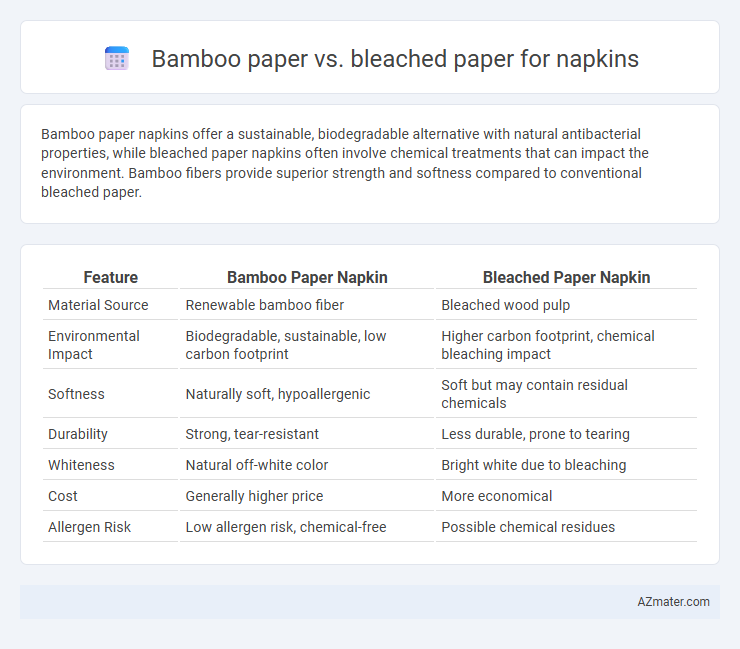Bamboo paper napkins offer a sustainable, biodegradable alternative with natural antibacterial properties, while bleached paper napkins often involve chemical treatments that can impact the environment. Bamboo fibers provide superior strength and softness compared to conventional bleached paper.
Table of Comparison
| Feature | Bamboo Paper Napkin | Bleached Paper Napkin |
|---|---|---|
| Material Source | Renewable bamboo fiber | Bleached wood pulp |
| Environmental Impact | Biodegradable, sustainable, low carbon footprint | Higher carbon footprint, chemical bleaching impact |
| Softness | Naturally soft, hypoallergenic | Soft but may contain residual chemicals |
| Durability | Strong, tear-resistant | Less durable, prone to tearing |
| Whiteness | Natural off-white color | Bright white due to bleaching |
| Cost | Generally higher price | More economical |
| Allergen Risk | Low allergen risk, chemical-free | Possible chemical residues |
Introduction: Understanding Napkin Material Choices
Bamboo paper napkins offer a sustainable alternative to traditional bleached paper napkins, with bamboo fibers providing natural antibacterial properties and greater softness. Bleached paper napkins undergo chemical processing to achieve their white appearance but may contain residues that can irritate sensitive skin and contribute to environmental pollution. Choosing between bamboo and bleached paper napkins involves balancing eco-friendliness, durability, and safety considerations for consumers and the planet.
Environmental Impact: Bamboo vs Bleached Paper
Bamboo paper napkins offer a significantly lower environmental impact compared to bleached paper, as bamboo is a rapidly renewable resource requiring less water and no pesticides during cultivation. Bleached paper napkins contribute to deforestation and involve chemical-intensive processes that release harmful dioxins and increase water pollution. Choosing bamboo napkins reduces carbon footprint and supports sustainable forestry, making them an eco-friendly alternative to conventional bleached paper options.
Raw Material Sourcing and Sustainability
Bamboo paper for napkins leverages bamboo's rapid growth and minimal need for pesticides, making it a highly sustainable raw material compared to traditional bleached paper sourced from slow-growing, often chemically treated hardwood and softwood trees. Bamboo's natural antibacterial properties and lower water consumption during cultivation reduce environmental impact, while bleached paper production typically involves chlorine-based chemicals that contribute to water pollution and deforestation. Choosing bamboo paper supports renewable resource use and reduces carbon footprint, positioning it as a more eco-friendly alternative in napkin manufacturing.
Manufacturing Process Comparison
Bamboo paper napkins are produced through a more sustainable manufacturing process involving fast-growing bamboo fibers that require less water and fewer chemicals than traditional wood pulp. In contrast, bleached paper napkins undergo intensive chemical treatments using chlorine or chlorine compounds to achieve their whiteness, increasing environmental impact and potential chemical residues. The bamboo process emphasizes mechanical and enzymatic treatments that preserve fiber strength while minimizing toxic effluents, making it a greener alternative compared to conventional bleached paper production.
Whiteness and Aesthetics: Visual Differences
Bamboo paper napkins exhibit a naturally off-white or creamy hue with subtle texture variations, enhancing an organic and eco-friendly aesthetic. Bleached paper napkins achieve a bright, uniform whiteness through chemical processing, resulting in a smooth and consistent surface ideal for formal settings. The visual difference lies in bamboo paper's warm, rustic appearance compared to the stark, clean brightness of bleached alternatives.
Softness and User Comfort
Bamboo paper napkins offer superior softness due to their natural fibers, providing enhanced user comfort compared to bleached paper napkins. Bleached paper napkins, treated with chemical processes, often feel harsher and less gentle on the skin. Bamboo napkins also maintain better absorbency and durability while being hypoallergenic, making them ideal for sensitive users.
Absorbency and Performance
Bamboo paper napkins offer superior absorbency due to their natural fiber structure, which allows for faster liquid absorption and better moisture retention compared to bleached paper napkins. The unbleached, chemical-free processing of bamboo paper enhances its durability and softness, resulting in a more reliable performance for everyday use. In contrast, bleached paper napkins, while often softer initially, tend to lose strength when wet, reducing their effectiveness in heavy-duty cleaning tasks.
Health and Safety Considerations
Bamboo paper napkins are naturally hypoallergenic, free from harsh chemicals, and biodegradable, reducing the risk of skin irritation and environmental toxins. Bleached paper napkins often undergo chemical processing with chlorine or chlorine dioxide, which can leave trace residues potentially harmful to sensitive skin and the environment. Choosing bamboo paper napkins supports safer, chemical-free hygiene while minimizing exposure to synthetic bleaching agents and their associated health risks.
Cost Analysis: Production and Consumer Pricing
Bamboo paper napkins typically incur higher production costs due to sustainable harvesting and specialized processing techniques, resulting in a consumer price premium compared to conventional bleached paper napkins. Bleached paper napkins benefit from established mass-production methods and lower raw material costs, making them more affordable for budget-conscious consumers. The long-term cost-effectiveness of bamboo napkins can improve with increasing demand and technological advancements in eco-friendly manufacturing.
Conclusion: Choosing the Right Napkin Material
Bamboo paper napkins offer superior sustainability, biodegradability, and hypoallergenic properties compared to bleached paper napkins, which rely on chemical whitening processes that may impact environmental health. Choosing bamboo paper supports eco-friendly practices by reducing deforestation and chemical waste while maintaining softness and absorbency suitable for sensitive skin. For conscientious consumers prioritizing environmental impact and product safety, bamboo napkins represent the optimal napkin material choice.

Infographic: Bamboo paper vs Bleached paper for Napkin
 azmater.com
azmater.com